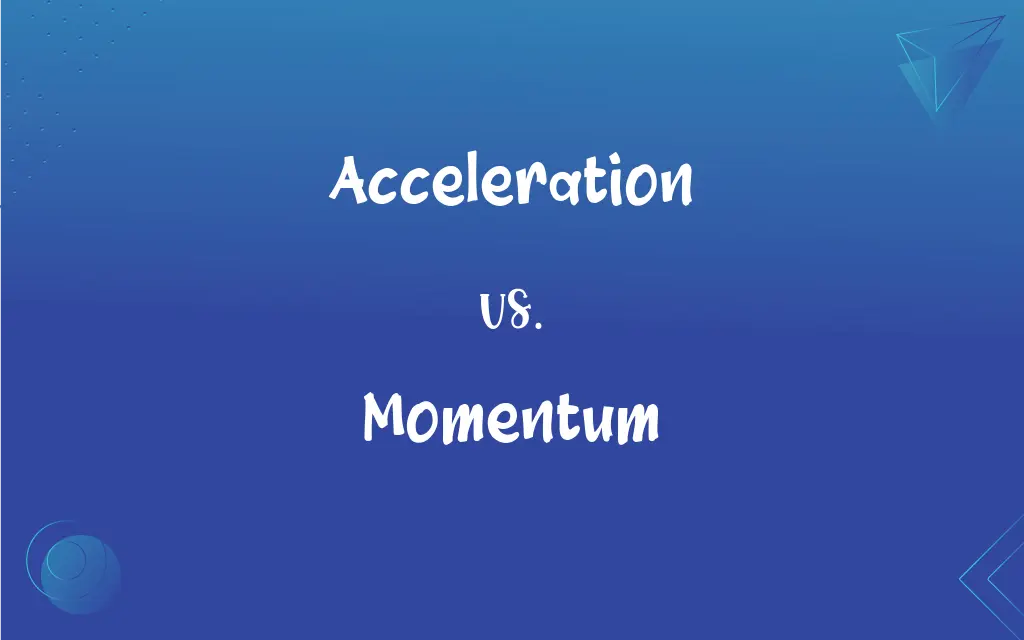Acceleration vs. Momentum: What's the Difference?
Edited by Aimie Carlson || By Janet White || Published on December 22, 2023
Acceleration is the rate of change of velocity of an object, whereas momentum is the product of an object's mass and velocity.

Key Differences
Acceleration is a measure of how quickly an object changes its velocity, indicating the rate of change over time. Momentum, on the other hand, represents the quantity of motion an object has, dependent on both its mass and velocity.
Acceleration directly relates to changes in velocity, whether an increase or decrease in speed or a change in direction. Momentum is influenced by velocity, but it is a product of both the object’s velocity and its mass.
Acceleration is measured in meters per second squared (m/s²). Momentum is measured in kilogram meters per second (kg·m/s).
Acceleration is a key concept in Newton's laws of motion, particularly the second law. Momentum is central to the principles of conservation of momentum and plays a vital role in collision and impulse scenarios.
Comparison Chart
Definition
Rate of change of velocity
Product of mass and velocity
ADVERTISEMENT
Measurement Unit
Meters per second squared (m/s²)
Kilogram meters per second (kg·m/s)
Relation to Velocity
Change in velocity over time
Product of mass with velocity
Dependent Factors
Depends on change in velocity and time
Depends on mass and velocity
Role in Physics
Central to Newton's second law
Key in conservation of momentum and collisions
Acceleration and Momentum Definitions
Acceleration
Acceleration is the rate at which an object's speed or direction changes over time.
The car's acceleration increased as it went from 0 to 60 mph in just a few seconds.
ADVERTISEMENT
Momentum
Momentum is a measure of the quantity of motion of a moving body, given by its mass multiplied by its velocity.
The momentum of the freight train made it difficult to stop quickly.
Acceleration
In physics, acceleration is a vector quantity, having both magnitude and direction.
The spacecraft experienced acceleration as it adjusted its orbit around the planet.
Momentum
Momentum is a conserved quantity, meaning it remains constant in a closed system unless acted upon by external forces.
In the collision, momentum was conserved as energy was transferred between the vehicles.
Acceleration
Negative acceleration, or deceleration, is the decrease in velocity over time.
The driver applied the brakes, causing the car to experience negative acceleration.
Momentum
Momentum is a vector quantity, possessing both magnitude and direction.
The soccer ball’s momentum changed as the player kicked it in a different direction.
Acceleration
Acceleration occurs when an object speeds up, slows down, or changes direction.
The roller coaster's acceleration was most intense as it descended the first hill.
Momentum
In collisions, momentum plays a crucial role in analyzing the after-effects.
Physicists calculated the momentum of each object to understand the dynamics of the collision.
Acceleration
Acceleration is the second derivative of displacement with respect to time.
Studying the ball's acceleration helped physicists understand its motion under gravity.
Momentum
Angular momentum is the rotational equivalent of linear momentum for rotating bodies.
The ice skater’s spin demonstrated conservation of angular momentum.
Acceleration
The act of accelerating.
Momentum
Symbol p(Physics) A quantity used to measure the motion of a body, equal to the product of the body's mass and its velocity. Also called linear momentum.
Acceleration
The process of being accelerated.
FAQs
What does momentum represent?
Momentum represents the quantity of motion a moving object has, based on its mass and velocity.
Can acceleration be negative?
Yes, negative acceleration, or deceleration, is when an object slows down.
Is momentum a vector quantity?
Yes, momentum is a vector, having both magnitude and direction.
How is acceleration calculated?
Acceleration is calculated as the change in velocity divided by the time taken for that change.
What units are used for momentum?
Momentum is measured in kilogram meters per second (kg·m/s).
How does mass affect momentum?
The greater the mass of an object, the greater its momentum for a given velocity.
What is acceleration?
Acceleration is the rate at which an object's velocity changes over time.
Does acceleration depend on mass?
Acceleration does not directly depend on mass; it depends on the force applied and the object’s mass according to Newton's second law.
Can acceleration occur in space?
Yes, objects in space can accelerate due to forces such as gravity.
What is conservation of momentum?
Conservation of momentum is the principle that in a closed system, the total momentum remains constant unless acted upon by external forces.
Can an object have momentum without acceleration?
Yes, an object can have constant momentum without accelerating if it maintains a constant velocity.
What factors affect acceleration?
Acceleration is affected by the magnitude of the force applied and the mass of the object.
Is momentum conserved in all collisions?
Yes, in all collisions, total momentum is conserved.
How is angular momentum different from linear momentum?
Angular momentum is associated with rotating objects, while linear momentum is for objects moving in a straight line.
Can an object’s momentum change without an external force?
No, an object’s momentum can only change due to an external force.
What happens to acceleration at constant velocity?
At constant velocity, acceleration is zero as there is no change in velocity.
What is the importance of acceleration in mechanics?
Acceleration is key in understanding the motion of objects under various forces.
What role does momentum play in sports?
Momentum is crucial in sports, affecting how players and objects move and interact.
Is momentum always positive?
No, momentum can be negative depending on the direction of velocity.
How does momentum affect vehicle safety?
Understanding momentum helps in designing safety features that manage forces during collisions.
About Author
Written by
Janet WhiteJanet White has been an esteemed writer and blogger for Difference Wiki. Holding a Master's degree in Science and Medical Journalism from the prestigious Boston University, she has consistently demonstrated her expertise and passion for her field. When she's not immersed in her work, Janet relishes her time exercising, delving into a good book, and cherishing moments with friends and family.
Edited by
Aimie CarlsonAimie Carlson, holding a master's degree in English literature, is a fervent English language enthusiast. She lends her writing talents to Difference Wiki, a prominent website that specializes in comparisons, offering readers insightful analyses that both captivate and inform.






































































